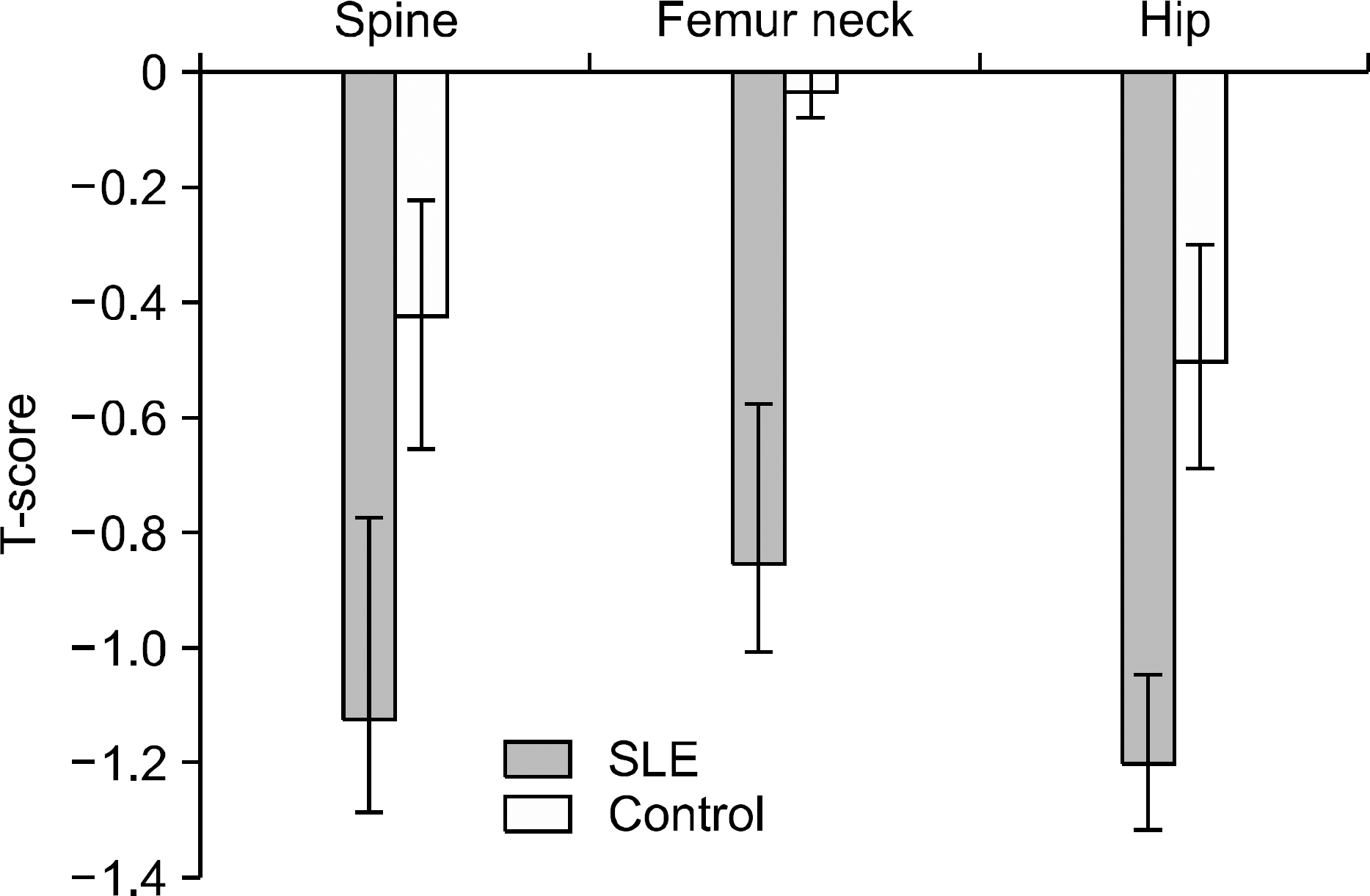1. Urowitz MB, Bookman AA, Koehler BE, Gordon DA, Smythe HA, Ogryzlo MA. The bimodal mortality pattern of systemic lupus erythematosus. Am J Med. 1976; 60:221–5.
2. Ginzler EM, Diamond HS, Weiner M, Schlesinger M, Fries JF, Wasner C, et al. A multicenter study of outcome in systemic lupus erythematosus. I. Entry variables as predictors of prognosis. Arthritis Rheum. 1982; 25:601–11.
3. Ward MM, Pyun E, Studenski S. Mortality risks associated with specific clinical manifestations of systemic lupus erythematosus. Arch Intern Med. 1996; 156:1337–44.
4. Ward MM, Pyun E, Studenski S. Causes of death in systemic lupus erythematosus. Longterm followup of an inception cohort. Arthritis Rheum. 1995; 38:1492–9.
5. Trager J, Ward MM. Mortality and causes of death in systemic lupus erythematosus. Curr Opin Rheumatol. 2001; 13:345–51.
6. Gordon C. Longterm complications of systemic lupus erythematosus. Rheumatology (Oxford). 2002; 41:1095–100.
7. Christian JC, Yu PL, Slemenda CW, Johnston CC Jr. Heritabili-ty of bone mass: a longitudinal study in aging male twins. Am J Hum Genet. 1989; 44:429–33.
8. Pocock NA, Eisman JA, Hopper JL, Yeates MG, Sambrook PN, Eberl S. Genetic determinants of bone mass in adults. A twin study. J Clin Invest. 1987; 80:706–10.
9. Johnston CC Jr, Miller JZ, Slemenda CW, Reister TK, Hui S, Christian JC, et al. Calcium supplementation and increases in bone mineral density in children. N Engl J Med. 1992; 327:82–7.
10. Morrison NA, Qi JC, Tokita A, Kelly PJ, Crofts L, Nguyen TV, et al. Prediction of bone density from vitamin D receptor alleles. Nature. 1994; 367:284–7.
11. Dalsky GP. The role of exercise in the prevention of osteoporosis. Compr Ther. 1989; 15:30–7.
12. Pacifici R. Estrogen, cytokines, and pathogenesis of postmenopausal osteoporosis. J Bone Miner Res. 1996; 11:1043–51.
13. Anderson GL, Limacher M, Assaf AR, Bassford T, Beresford SA, Black H, et al. Effects of conjugated equine estrogen in postmenopausal women with hysterectomy: the Women's Health Initiative randomized controlled trial. JAMA. 2004; 291:1701–12.
14. Canalis E. Clinical review 83: Mechanisms of glucocorticoid action in bone: implications to glucocorticoid-induced osteoporosis. J Clin Endocrinol Metab. 1996; 81:3441–7.
15. Haugeberg G, Ørstavik RE, Kvien TK. Effects of rheumatoid arthritis on bone. Curr Opin Rheumatol. 2003; 15:469–75.
16. Lacativa PG, Farias ML. Osteoporosis and inflammation. Arq Bras Endocrinol Metabol. 2010; 54:123–32.
17. Tanaka Y, Watanabe K, Suzuki M, Saito K, Oda S, Suzuki H, et al. Spontaneous production of bone-resorbing lymphokines by B cells in patients with systemic lupus erythematosus. J Clin Immunol. 1989; 9:415–20.
18. MacDonald BR, Gowen M. Cytokines and bone. Br J Rheumatol. 1992; 31:149–55.
19. Report of a WHO Study Group. Assessment of fracture risk and its application to screening for postmenopausal osteoporosis. World Health Organ Tech Rep Ser. 1994; 843:1–129.
20. Redlich K, Ziegler S, Kiener HP, Spitzauer S, Stohlawetz P, Bernecker P, et al. Bone mineral density and biochemical param-eters of bone metabolism in female patients with systemic lupus erythematosus. Ann Rheum Dis. 2000; 59:308–10.
21. García-Carrasco M, Mendoza-Pinto C, Escárcega RO, Jiménez-Hernández M, Etchegaray Morales I, Munguía Realpozo P, et al. Osteoporosis in patients with systemic lupus erythematosus. Isr Med Assoc J. 2009; 11:486–91.
22. Kipen Y, Buchbinder R, Forbes A, Strauss B, Littlejohn G, Morand E. Prevalence of reduced bone mineral density in systemic lupus erythematosus and the role of steroids. J Rheumatol. 1997; 24:1922–9.
23. Bhattoa HP, Bettembuk P, Balogh A, Szegedi G, Kiss E. Bone mineral density in women with systemic lupus erythematosus. Clin Rheumatol. 2002; 21:135–41.
24. Bhattoa HP, Kiss E, Bettembuk P, Balogh A. Bone mineral density, biochemical markers of bone turnover, and hormonal status in men with systemic lupus erythematosus. Rheumatol Int. 2001; 21:97–102.
25. Lakshminarayanan S, Walsh S, Mohanraj M, Rothfield N. Factors associated with low bone mineral density in female patients with systemic lupus erythematosus. J Rheumatol. 2001; 28:102–8.
26. Tan EM, Cohen AS, Fries JF, Masi AT, McShane DJ, Rothfield NF, et al. The 1982 revised criteria for the classification of systemic lupus erythematosus. Arthritis Rheum. 1982; 25:1271–7.
27. Park HA, Park JK, Park SA, Lee JS. Age, menopause, and cardiovascular risk factors among korean middle-aged women: the 2005 Korea National Health and Nutrition Examination Survey. J Womens Health (Larchmt). 2010; 19:869–76.
28. Bombardier C, Gladman DD, Urowitz MB, Caron D, Chang CH. Derivation of the SLEDAI. A disease activity index for lupus patients. The Committee on Prognosis Studies in SLE. Arthritis Rheum. 1992; 35:630–40.
29. Genant HK, Cooper C, Poor G, Reid I, Ehrlich G, Kanis J, et al. Interim report and recommendations of the World Health Organization Task-Force for Osteoporosis. Osteoporos Int. 1999; 10:259–64.
30. Molina B, Lassaletta A, Andion M, Gonzalez-Vicent M, López-Pino MA, et al. A Persistent epidural mass in a child with B-lin-eage ALL. Pediatr Blood Cancer. 2010; 55:727–9.
31. Warne GL, Fairley KF, Hobbs JB, Martin FI. Cyclophospha-mide-induced ovarian failure. N Engl J Med. 1973; 289:1159–62.
32. Mok CC, Lau CS, Wong RW. Risk factors for ovarian failure in patients with systemic lupus erythematosus receiving cyclophosphamide therapy. Arthritis Rheum. 1998; 41:831–7.
33. Hofbauer LC, Gori F, Riggs BL, Lacey DL, Dunstan CR, Spelsberg TC, et al. Stimulation of osteoprotegerin ligand and inhibition of osteoprotegerin production by glucocorticoids in human osteoblastic lineage cells: potential paracrine mechanisms of glucocorticoid-induced osteoporosis. Endocrinology. 1999; 140:4382–9.
34. Van Staa TP, Leufkens HG, Cooper C. The epidemiology of cor-ticosteroid-induced osteoporosis: a meta-analysis. Osteoporos Int. 2002; 13:777–87.
35. Dalle Carbonare L, Arlot ME, Chavassieux PM, Roux JP, Portero NR, Meunier PJ. Comparison of trabecular bone micro-architecture and remodeling in glucocorticoid-induced and postmenopausal osteoporosis. J Bone Miner Res. 2001; 16:97–103.





 PDF
PDF ePub
ePub Citation
Citation Print
Print


 XML Download
XML Download